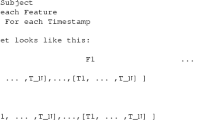Abstract
Recently, several non-deterministic distance embedding methods that can be used for fast dimension reduction have been proposed in the machine learning literature. These include FastMap, MetricMap, and SparseMap. Among them, FastMap, implicitly assumes that the objects are points in a p-dimensional Euclidean space. It selects a sequence of k ≤ p orthogonal axes defined by distant pairs of points (called pivots) and computes the projection of the points onto the orthogonal axes. We show that FastMap picks all of its pivots from the vertices of the convex hull of the data points in the original implicit Euclidean space. This provides a connection to results in robust statistics, where the convex hull is used as a tool in multivariate outlier detection and in robust estimation methods. The connection sheds a new light on some properties of FastMap and provides an opportunity for a robust class of dimension reduction algorithms that we call RobustMaps, which retain the speed of FastMap and exploit ideas in robust statistics. One simple RobustMap algorithm is shown to outperform principal components on contaminated data both in terms of clean variance captured and in terms of time complexity.
Access this chapter
Tax calculation will be finalised at checkout
Purchases are for personal use only
Preview
Unable to display preview. Download preview PDF.
Similar content being viewed by others
References
Abu-Khzam F.N., Samatova N., Ostrouchov G., Langston M.A., Geist A. (2002). Distributed dimension reduction algorithms for widely dispersed data. In Parallel and Distributed Computing and Systems, ACTA Press, 174–178.
D. O. E. (1990). Atmospheric radiation measurement program plan. Technical Report DOE/ER-0441, U. S. Department of Energy,Oce of Health and Environmental Research, Atmospheric and Climate Research Division, National Technical Information Service, 5285 Port Royal Road, Springfield, Virginia 22161.
Donoho D.L., Huber P.J. (1983). The notion of breakdown-point. In Bickel, Doksum, and Hodges, (eds), Festschrift fur Erich L. Lehmann, Belmont, CA, Wadsworth 157–184.
Downing D.J., Fedorov V.V., Lawkins W.F., Morris M.D., Ostrouchov G. (2000). Large data series: Modeling the usual to identify the unusual. Computational Statistics & Data Analysis 32 245–258.
Erickson J. (1999). New lower bounds for convex hull problems in odd dimensions. SIAM J. Comput. 28(4), 1198–1214.
Faloutsos C., Lin K. (1995). FastMap: A fast algorithm for indexing, data-mining and visualization of traditional and multimedia dataseis. In ACM SIGMOD Conference, San Jose, CA, May 1995, 163–174.
Gallier J.H. (2000). Geometric methods and applications for computer science and engineering. Springer.
Hjaltason G.R., Samet H. (2003). Properties of embedding methods for similarity searching in metric spaces. IEEE Transactions on Pattern Analysis and Machine Intelligence 25, 530–549.
Hotelling H. (1933). Analysis of a complex of statistical variables into principal components. J. Educ. Psych. 24, 417–441, 498-520.
Huber P.J. (1972). Robust statistics: A review. Annals Mathematical Statistics 43(4), 1041–1067.
Huber P.J. (1981). Robust statistics. John Wiley & Sons, New York.
Ruts I., Rousseeuw P.J. (1996). Computing depth contours of bivariate point clouds. Computational Statistics & Data Analysis 23, 153–168.
Stewart G.W. (1999). The QLP approximation to the singular value decomposition. SIAM J. Sci. Comput. 20(4), 1336–1348.
Torgerson W.S. (1952). Multidimensional scaling i: Theory and method. Psychometrika 17, 401–419.
Ziegler G.M. (1995). Lectures on polytopes. Springer-Verlag.
Author information
Authors and Affiliations
Editor information
Editors and Affiliations
Rights and permissions
Copyright information
© 2004 Springer-Verlag Berlin Heidelberg
About this paper
Cite this paper
Ostrouchov, G., Samatova, N.F. (2004). Embedding Methods and Robust Statistics for Dimension Reduction. In: Antoch, J. (eds) COMPSTAT 2004 — Proceedings in Computational Statistics. Physica, Heidelberg. https://doi.org/10.1007/978-3-7908-2656-2_29
Download citation
DOI: https://doi.org/10.1007/978-3-7908-2656-2_29
Publisher Name: Physica, Heidelberg
Print ISBN: 978-3-7908-1554-2
Online ISBN: 978-3-7908-2656-2
eBook Packages: Springer Book Archive




